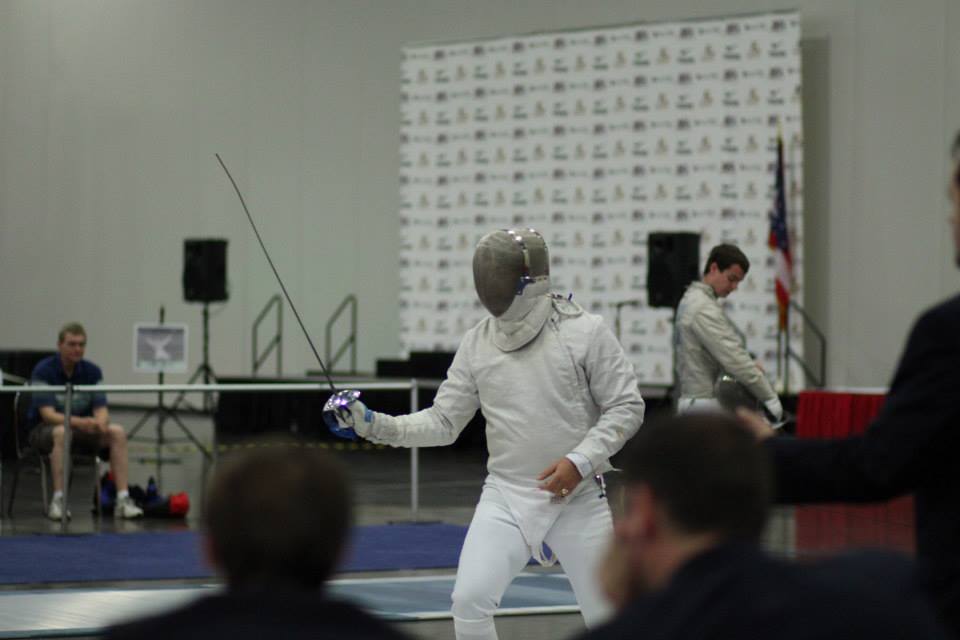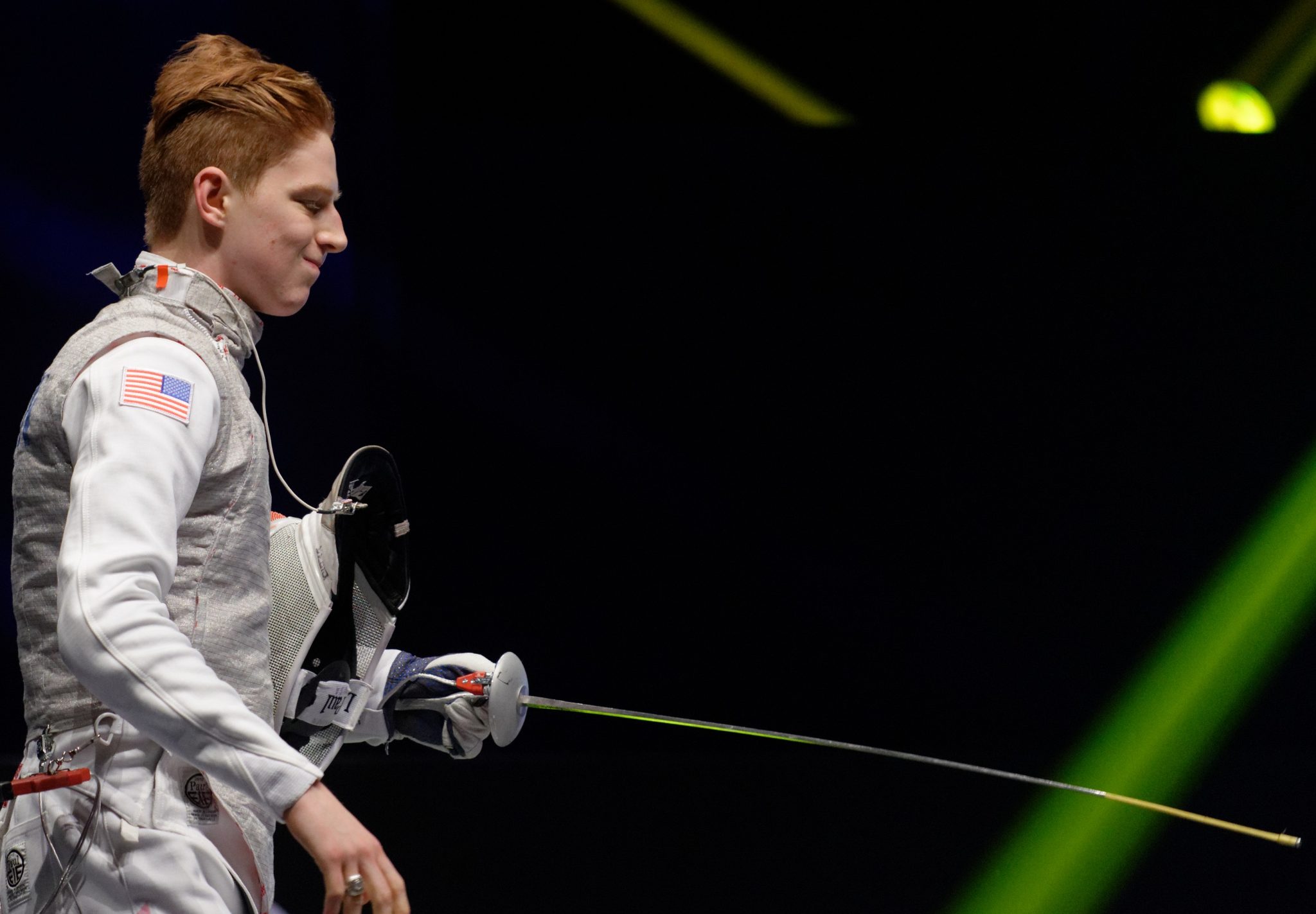
Unless you’re a member of the Mo, Sirico, Simmons, or Horowitz families, chances are, you’re scratching your heads wondering “what went wrong and what could have gone better at summer nationals?” I know I am. Whether it was my subpar conditioning that couldn’t get me through Division III Saber or the fact that Division I Epee had too many freakishly fast teenagers, I know that with the end of the 2013-2014 season, it’s time to get back to the drawing board.
For younger fencers who are just becoming acclimated to the lifelong cycle of sorrow and glory that fencing brings you, it’s easy to look at Summer Nationals and be dismayed by your results, but to quote Winston Churchill, “A pessimist sees the difficulty in every opportunity; an optimist sees the opportunity in every difficulty.”
Prior to the 2014 Summer Nationals, one of my students earned his B and qualified for his first Division I. Leading up to the tournament, we agreed on the expectation that this tournament was not an “in it to win it” competition, but a means of benchmarking himself against others and understanding the intense speed and tempo that these tournaments operate at. The student I speak of managed to squeak out of pools before drawing 2007 Cadet World Champion Graham “The King of the Babies” Wicas and losing. It could have been easy to look at his exit in the 256 and say “that’s not a good result,” but the student understood that getting out of pools and simply competing at this level was an accomplishment in itself.
When you compete at nationals (especially when it’s your first one, or your first foray into a new age category), the status of your fellow competitors can be eye-opening. Don’t fret, because remember, failure is the antecedent to future success if channeled and understood properly. Now that each and every one of us, including this year’s national champions, is back to the drawing board, there are a few things that each and every one of us can focus on.
- Footwork, footwork, footwork- No matter who you are or where you’re ranked, there can never be enough emphasis on footwork. Three-time Olympian Kelley Hurley once told me that she and her sister Courtney can spend up to four hours a day on footwork with little emphasis on bouting , mostly because of lack of proximity to a club. Practice shadow fencing. It can help you visualize movement and how to vary footwork and distance from opponent to opponent. And for the epee and foil crews, the trend I’m seeing so much more and more of is the growth of the half advance in preparation to invite the attack and deceive distance. Go half advance until the cows come home.
- Stop practicing bouting to win- Teenage fencers, you guys like to get in a pissing contest in practice and go for the win. I get it. It’s a matter of pride. Let me help you change this philosophy for the next season. Here’s an idea: practice is an opportunity to innovate. The more you play around, try new things, and practice what you have learned in lessons/classes with repetition, the more your repertoire and creativity on the strip will expand. Following a lesson, I am okay with losing a bout 15-5 as long as I’ve prepared and executed an action or two that I’ve learned in a lesson. If I’ve watched YouTube and seen something I could apply, I’ll play around and try to weasel it into practice. It’s easy to get competitive in practice, and that’s not necessarily a bad thing the closer you get to a competition, but take this season to stop going for the win in practice and aim for innovation.
- YouTube is your friend- I tend to stress this point like a broken record, but YouTube is such a valuable asset to your training and preparation for a tournament. The upcoming 2014 World Championships in Kazan will be streamed live on the FIE’s YouTube Channel, and should be viewed by every fencer aspiring to greatness. Spending at least an hour of week watching videos on YouTube can help you digest a variety of things:
- YouTube helps you understand trends in global fencing and recognize how to apply these trends to your game.
- YouTube provides a means to scout your potential opponents and be a step ahead of them when you go toe-to-toe on the piste.
- YouTube helps you understand tactics and distance at an advanced level. In studying tactics and what others are doing, you can emulate this behavior in your bouts and truly play the game of physical chess.
- YouTube has lots of funny cat videos and teaches you how to turn into a Super Saiyan.
- Have fun- I stopped having fun sometime this season, so I started messing around with saber in order to rekindle the love of fencing, and it worked! I’m having more fun than I have in years. One of my main takeaways and observations from the Summer Nationals was the joie-de-vivre with which Polish Olympian Marek Stepien approached Division I-A Men’s Epee. He was working the crowd, he was smiling, and he was kicking butt all the way to his bronze medal (at the age of 50!). Fencing is fun, and here’s a montage of athlete quotes to remind you:
- “…always remember that fencing is a heck of a lot of fun. It’s easy to lose track of that when you get so focused on your results and the frustrations of training. Enjoy hanging out with friends and don’t take defeats and setbacks too hard.” –Jonathan Yergler, NCAA Champion
- “I believe it’s important to remember that fencing is fun. Once you start seriously competing, the fun of fencing can get sucked out…For me, the best way to overcome all of that is to remember that the reason I started going to tournaments was because it was fun.” – Jason Pryor, 2x U.S. Men’s Epee National Team Member
- “A large piece of advice that I must give to young fencers is to not let anybody take the fun out of fencing. You must train hard and motivate yourself to work harder and do better, but you cannot go overboard on it.” – Ari Simmons, 2013 Cadet World Champion. Fencing is fun, so don’t lose sight of that!
- Learn to fence the referee- No no, that does not mean to bludgeon the referee with your blade. We don’t do that? Ok? We don’t do that. As I competed in my first right of way weapon nationals, I had one of those “ah-hah” moments, which is probably a stupid epiphany that most of you foilists and sabrists have already had: it is of equal importance to sell the touch to the referee as it is to land it on your opponent. What a referee in your division might call a full extension to a cut might be different from how Joe Referee from South Carolina calls it. Take this season to understand not only the opponents you fence, but to digest how to read your referees and sell the touch. No matter the quality of the referee, every single one sees a bout differently. The easier the fencer sells it, the easier it is to win.
- Question everything- One of my favorite weekly lessons to give is to a Veteran fencer who asks me “why?” after every action I show her. It’s not because she doubts me (I hope), but because she wants to understand the tactics behind the action and how to apply them to her bouts. When you take lessons, don’t be afraid to initiate dialogue with coach. It’s easy to follow blindly, but take this season to ask “why?” when you learn from your coach. Gain a better understanding of everything you’re doing on the strip. The best way to do that is to not only learn the motions, but the tactic behind each motion. A key to becoming a successful fencer is to think for yourself, which leads me to…
- Become more independent- You don’t need your coach to tell you to get off your tush and work. You don’t need your coach to hold your hand through every tournament and tell you what to do in every hairy situation in a bout. Your coach shows you the “how” and tells you the “why,” but the onus of responsibility falls on you, and only you to succeed. Walking around at Summer Nationals, I saw many athletes who looked lost trying to find their coaches before eliminations, rather than focusing on the bout at hand. Become your own fencer this year. Coach won’t always be there to guide you.
For those of you who didn’t gain the success you wanted in 2013-2014, here’s to the next season. For those who did, back to the drawing board you go. Best of luck as you continue your journeys in the sport of fencing.





